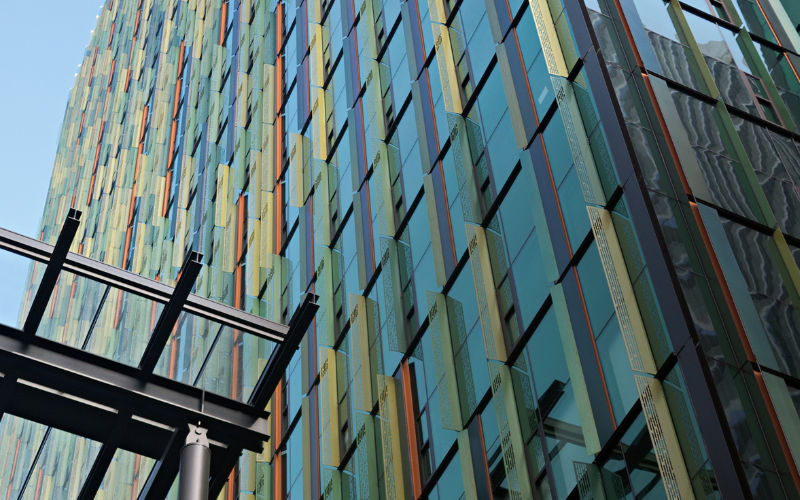Back | Blog posts overview
Adding a splash of color
Who said skyscrapers must all be uniformly grey? Electrochemically colored stainless steel adds some whimsy to Seattle's new Doppler Building. The invigorating stripes of color serve as an antidote to the city's often cloudy skies. Below these stripes, a series of stainless steel sculptures at the building's base demonstrate another artistic application of this unique metal.

© Nicole Kinsman
Rising 36 stories above Seattle's South Lake Union neighborhood is a sustainable beauty, created by NBBJ and adorned with molybdenum-containing Type 316 stainless steel. Even to 21st-century eyes, craning one's neck to assess the stature of a towering skyscraper remains a humbling prospect. And when looking up to see ribbons of color splicing the utilitarian grey, perhaps it is in admiration of the architecture of the future.
Stainless, stylish and sustainable
Perforated and electrochemically colored stainless steel "fins" separate the Doppler building from the rest of the Seattle skyline. The building's glass reflects an ever-changing spectacle of color, causing variations in light playing off the vertically oriented fins. This dance of light and color draws the eye upwards. Stainless steel is used in two places: in brown and champagne-colored panels on the side of the building, measuring 1.2 millimeters thick, and in protruding red and green fin panels, measuring 1.5 millimeters thick. The reflections of these colored panels off the glass transform the structure's 160-meter-high façade, designed by POHL, from office to artwork.
The Doppler Building houses Amazon's corporate headquarters, but its design also enhances the overall Seattle cityscape. Its campus includes a through-block plaza with food stalls and art work. The building received a U.S. Green Building Council LEED gold certification for its ecological design and use of sustainable materials, including stainless steel. This stainless steel has a high recycled content. Stainless steel's durability and longevity are also frequently considered during USGBC LEED certification. When a Whole Building LCA analysis is conducted as part of the assessment, longevity, and maintenance must be evaluated. For example, if the colored panels were made of a shorter life material or one that required regular repainting, instead of electrochemically colored stainless steel, replacement over a 65-year service life would be expected. But properly specified and maintained stainless steel panels should last the life of the building. Stainless steel offers the potential for significantly greater longevity over other materials, thereby potentially improving a building's USGBC LEED score.
Read more to find out why the 2% molybdenum content in Type 316 stainless steel serves to protect against the corrosive elements present in Seattle's climate and contributes to stainless steel's sustainability credentials.
Back | Blog posts overview

